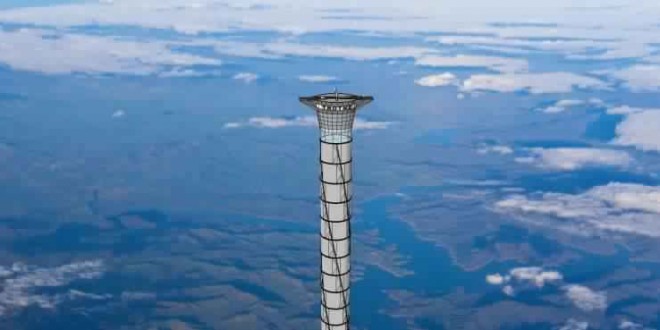A Canadian space firm is one step closer to revolutionising space travel with a simple idea – instead of taking a rocket ship, why not take a giant elevator into space?
Thoth Technology Inc has been granted both U.S. and U.K. patents for such a structure, which, if constructed, would be more than 20 times the height of the Burj Khalifa — the tallest structure built by humankind.
“Astronauts would ascend to 20 km [12.5 miles] by electrical elevator. From the top of the tower, space planes will launch in a single stage to orbit, returning to the top of the tower for refueling and re-flight,” Brendan Quine, the inventor of the tower — named the ThothX Tower — said, in a statement.
As explained in the patent, the space elevator’s tower would have a segmented elevator core structure, with each segment formed of at least one pneumatically pressurized cell. Elevator cars — each of them capable of carrying up to 10 tons of cargo — would travel either on the outer surface of the tower or through the core — much like a pneumatic tube message system.
In order to stabilize the 12.5-mile tall structure and to compensate for tower bending, a complex arrangement of gyroscopes and flywheels would be needed.
In theory, space elevators can be a cheaper alternative to rocket launches, especially for missions that involve sending heavy payloads into orbit or deep space. According to the company statement, use of the space elevator might save up to 30 percent of fuel used by a conventional rocket. Moreover, since the entire structure would be made using reusable hardware, it would further slash costs.
“Part of the limitation on space travel is the cost of getting to space,” Quine told the Guardian. “The tower could change space travel because professional rockets are very energy intensive and not very environmentally friendly.”
Caroline Roberts, president and chief executive of Thoth Technology, said that the space elevator, along with self-landing rocket technologies being tested by companies like SpaceX, has the potential to usher in a new era of space transportation.
“Landing on a barge at sea level is a great demonstration, but landing at 12 miles above sea level will make space flight more like taking a passenger jet,” Roberts said, in the statement, referring to recent attempts by SpaceX to land its Falcon 9 rocket on a drone barge off the eastern United States.
Agencies/Canadajournal
 Canada Journal – News of the World Articles and videos to bring you the biggest Canadian news stories from across the country every day
Canada Journal – News of the World Articles and videos to bring you the biggest Canadian news stories from across the country every day



